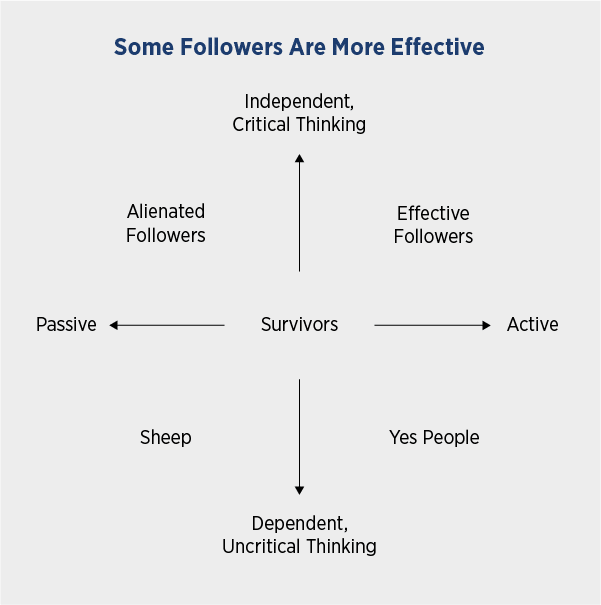Management is often assumed to be the story of Leader and Followers. But truly understanding Followership is critical to understand how organisations work. We are so ingrained in the idea that Leadership is critical, that we tend to forget that a Leader alone won’t be able to achieve much. The role of Leadership is overrated in organisations. The role of Followership is instead underrated. With this article, I want to shed some light on this conundrum and offer some personal perspectives on how to be able to improve on both fronts. The idea of this post came by reading the book Yes to the Mess by Frank J. Barrett that I have recently reviewed.
A leader is only as good as his or her followers.
Doug Williamson
Defining Followership
It is the ability to take direction well, to get in line behind a program, to be part of a team and to deliver on what is expected of you.
John S. McCallum, Followership, the other side of Leadership
The concept of Followership dates back down to the first studies on Leadership, but it is only in 1988 that an article on HBR, In Praise of Followers, was entirely dedicated on the topic, written by Robert Kelley. He focuses on precisely the point that the entire management development industry has focused almost exclusively on Leadership. Forgetting that every manager in an organisation has another manager. Followership dominates our lives and organisations, but not our thinking, because our preoccupation with Leadership keeps us from considering the nature and the importance of the follower.
Types of Followers
Bosses are not necessarily good leaders; subordinates are not necessarily effective followers.
Robert Kelley, In Praise of Followers
He then questions what makes a person an effective follower. He summarises this the following way: enthusiastic, intelligent, and self-reliant participation in the pursuit of an organisational goal. The purpose of becoming leaders can motivate some Followers. But Kelley stresses that there are different forms of Motivation to be considered. And has developed a matrix based on two dimensions: One dimension measures to what degree followers exercise independent, critical thinking. The other ranks them on a passive/active scale. The resulting diagram identifies five followership patterns.

Image reviewed by Eagles’ Flight
- Sheep are passive and uncritical, lacking initiative and sense of responsibility. They are mere executors of what is being told to them.
- Yes People are more proactive, but still unenterprising, their egos often focused to please the Leader rather than to seek what’s best for the organisation. They can be even servile. Bosses weak in judgment and self-confidence tend to like them and to form alliances with them that can stultify the organisation.
- Alienated Followers are independent and critical in their thinking, but have given up in their initiative. Something turned them off. Often cynical, they tend to sink gradually into disgruntled acquiescence, seldom openly opposing a leader’s efforts.
- Survivors live in the centre of the diagram. They perpetually sample the wind and live by the slogan “better safe than sorry.” They are adept at surviving change.
- Effective Followers instead share positive levels of initiative and critical thinking. They are energetic and assertive. Followership of this kind can be a positive and acceptable choice for parts or all of our lives—a source of pride and fulfilment.
Building Effective Followers
Building Effective Followers in an organisation is not an easy task. The focus should be on looking at the key behaviours they display. Here the list that Kelley developed.
- Self-Management: They manage themselves well.
- Commitment: They are committed to the organisation and to a purpose, principle, or person outside themselves.
- Competence and Focus: They build their expertise and focus their efforts for maximum impact.
- Courage: They are courageous, honest, and credible.
He immediately notices that these behaviours almost entirely overlap those of ideal Leaders. Our stereotyped minds, however, don’t seem to be allowing that, and instead, look for followers in the bottom quadrants of the matrix.
To be able to develop a genuine concept of Followership, we need to jointly rethink the concepts of Leadership and Followership in our organisations. If this was already evident for a manager of the eighties, it becomes even more critical today in a scenario in which traditional hierarchical organisations are put in discussion in favour of more flexible, networked forms and structures.
We also need to teach followership skills. All our Talent Management system is biased to the idea that we need to show Leadership, as followers simply know how to follow. The lesson that Frank Barrett gives in his book Yes to the Mess, articulating the parallel with the Jazz Groups, is paramount. There we learn that the Leader of a Jazz band takes the mission to teach Followership through Generous Listening continually. They are developing an authentic learning environment.
We need to teach Followership by ensuring we focus on the many and not just on the few. Thanks to flat organisational models, it will be easier to give leadership opportunities for more people, and we can do so only by creating definite Followership. We also have to avoid thinking only in one or two dimensions, because good Followership displays several complex skills.
Think of the thousands of companies that achieve adequate performance and lackluster profits with employees they treat like second-class citizens. Then imagine for a moment the power of an organization blessed with fully engaged, fully energized, fully appreciated followers.
Robert Kelley, In Praise of Followers
The question now is, but how do Followership and Leadership link to each other?
Followership and Leadership: Banking on Credibility
How does this relationship work? I found a video by Doug Williamson that explains this very well. He asks himself how do leaders earn their Followership? The critical aspect here is credibility, a quality that, in his words, is like a currency. You “bank-in” credibility through the Quality of Your Decisions and the Quality of Interactions with People. And you need to regularly bank in”. Because there are going to be moments when the Leader will need Permission to Lead based on how much credibility she has accrued. In the hard moments of organisational life, it’s the followers that determine whether the Leader can lead.
By the way, this is not an entirely new concept. Chester Barnard wrote about it in his milestone work The Functions of the Executive in 1938.
The decision as to whether an order has authority or not lies with the person to whom it is addressed, and does not reside in ‘persons of authority’ or those who issue orders.
Chester I. Barnard, The Functions of the Executive, 1938
Conclusion: between Followership and Leadership
I hope I’ve been able to paint a different vision on the relationship between Leader and Followers. Reading about this has been a personal discovery, that has allowed me to “join the dots” on many different concepts. Building energetic Followers is essentially the battle that Corporate Rebels is trying to achieve, and most of the Rebel Organisations they are looking at have built active Cultures of Followership. It’s about making a “Good Enough” attitude around the organisation. It’s the Rebel Talent that Francesca Gino has written about. The quest between Followership and Leadership is another way of looking at the debate we have seen during this year’s HR Congress, on the role of HR: is it about Culture or Talent? It also gives a new perspective on how we can best prepare for the Work of the Future with our set of solid skills. It’s also not a choice between the two: we still need good Leaders, but we can derive them from an effective Followership.
And you? Are you an Effective Follower?

Cover Photo by Jehyun Sung on Unsplash

[…] member of the group takes the lead, but never in isolation. Everybody else listens and supports, creating authentic followership. This concept seems so distant from that of Leadership that I will be dedicating some more time in […]
[…] and Management at Wilfred Laurier University School of Business & Economics, on the topic of Followership and […]
[…] can bring out the creativity of the partner in the leader role. A great add-in to the concept of Followership we have already […]
[…] is not only an organisational attribute but also an individual one. Its the way we can develop Followership as well as Leadership. As we develop the Organization of the Future, we need to tap into this wealth of […]
[…] Another word that holds the seeds of Hierarchy is Leadership as it implicitly recognises at least a grading of competence between great leadership and low leadership, if not a distinction between leaders and followers. […]
[…] have been linked to Murmuration, but this topic is more then a relationship between leadership and followership. It’s about entangling self-management in it true sense, based on the shortest possible […]